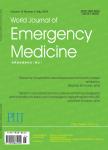Patient tracking in earthquake emergency response in Iran: A qualitative study
Patient tracking in earthquake emergency response in Iran: A qualitative study作者机构:Health Management and Economics Research Center Isfahan University of Medical Sciences Isfahan Iran Health Information Management Tehran University of Medical Sciences Tehran Iran Social Determinants of Health Research Center Isfahan University of Medical Sciences Isfahan Iran
出 版 物:《World Journal of Emergency Medicine》 (世界急诊医学杂志(英文))
年 卷 期:2017年第8卷第2期
页 面:91-98页
核心收录:
学科分类:1004[医学-公共卫生与预防医学(可授医学、理学学位)] 1002[医学-临床医学] 100402[医学-劳动卫生与环境卫生学] 10[医学]
基 金:supported by vice chancellery of research Isfahan University of Medical Sciences
主 题:Patient tracking Emergency response Qualitative study Earthquake
摘 要:BACKGROUND: After a disaster, all victims have to be rapidly and accurately identified for locating, tracking and regulating them. The purpose of this study was to summarize people s experiences that how the patients were tracked in past earthquake disasters in Iran.METHODS: A qualitative study was carried out in 2015. This was an interview-based qualitative study using content analysis. The interviewed people included physicians, nurses, emergency medical technicians, disaster managers, Red Crescent Society first responders and managers. Participants were identified using a snow ball sampling method. Interviews were audiotaped, transcribed, coded, and entered into MAXQDA(version 10) for coding and content analysis.RESULTS: Three main themes and seven categories including content(recoding data), function(identification of victims, identification of the deceased, informing the patients relatives, patients evacuation and transfer, and statistical reporting), technology(the state of using technology) were identifi ed that showed the patient tracking status in past earthquakes in Iran.CONCLUSION: Participants believed that to identify and register the data related to patients or the dead, no consistent action plan was available. So developing a consistent patient tracking system could overcome this issue and improve patient safety.



